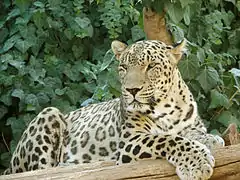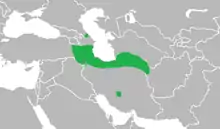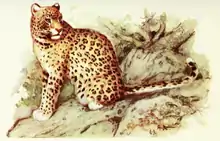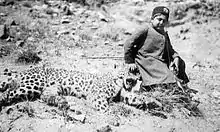波斯豹
波斯豹(學名:Panthera pardus ciscaucasica)也稱高加索豹,是體型最大的豹亞種,原來只生活在土耳其東部、高加索山脈和伊朗北部、土庫曼斯坦南部和阿富汗西部部份地區。在所有分佈地區都已經瀕危,成年個體約有871–1,290只,並且其數量依然在不斷下降。[1]19世紀劃分出的、原產於土耳其西南部的安納托利亞豹(Panthera pardus tulliana)現已併入該亞種。[2]
| 波斯豹 | |
|---|---|
 | |
| 保护状况 | |
| 科学分类 | |
| 界: | 动物界 Animalia |
| 门: | 脊索动物门 Chordata |
| 纲: | 哺乳纲 Mammalia |
| 目: | 食肉目 Carnivora |
| 科: | 猫科 Felidae |
| 属: | 豹属 Panthera |
| 种: | 豹 P. pardus |
| 亚种: | 波斯豹 P. p. ciscaucasica |
| 三名法 | |
| Panthera pardus ciscaucasica Satunin, 1914 | |
 | |
| 異名 | |
|
Panthera pardus saxicolor Pocock, 1927 | |
分類學
俄羅斯探險家康斯坦丁·薩圖寧在1914年依據一具來自庫班河地區的標本,首次以P.p. ciscaucasica命名波斯豹。[3]1927年,英國動物學家雷金納德·英尼斯·波考克以一具不同地區的標本將之命名為 P. p. saxicolor[4]。現二者已被認為是同一個物種。[5]
分佈與棲息地

波斯豹曾分佈在幾乎整個高加索地區,2001年至2005年間的一項調查顯示大高加索以西已經不存在波斯豹了,伊朗是現在擁有波斯豹最多的國家。[9]1992年蘇聯解體使得波斯豹保護系統被削弱,也造成了一定數量的波斯豹被獵殺。相關的數據不足也影響了對其現狀的更確切評估。[10]
2008年,世界上大約只存在871–1,290只成年波斯豹:[1]
- 550–850只在伊朗[7]
- 200–300只在阿富汗,具體情況不明
- 78–90只在土庫曼斯坦
- 少於10–13只在亞美尼亞
- 少於10–13只在阿塞拜疆
- 少於10只在俄羅斯北高加索
- 少於5只在土耳其[11]
- 少於5只在格魯吉亞
- 約3 -4只在纳戈尔诺-卡拉巴赫
波斯豹遠離沙漠、常年積雪地和都市地區。[12]其棲息地包括大高加索的亞高山帶草甸、闊葉林帶和崎嶇的山澗以及伊朗和小高加索的山地及針葉林帶。[9]只有少數孤立個體才四處活動。一些地區的物種數量依靠伊朗波斯豹的遷徙才得以維持。[13]
伊朗
實際上波斯豹在伊朗各地都有分佈,只是北多(69%)南少。[7]現存於74個受保護地區和非保護區中,主要發現於厄爾布爾士山脈、札格羅斯山脈。伊朗的厄爾布爾士山脈的赫卡尼亞森林被認為是該國最終要的波斯豹保護區,該地溫度在−23 °C(−9 °F)-49 °C(120 °F)之間,不過波斯豹最常見於溫度為13~18 °C(55~64 °F),年降雨量超過200毫米的地區。[14]
伊朗的中厄爾布爾士保護區是該國最大的波斯豹保護區,面積約3,500平方(1,400平方英里)。[15]2008年1月一隻雄性波斯豹被發現在小檗属植物下撒尿,之後它有數次在同一地區被拍攝到。[16]
在設拉子東北部的班慕國家公園,設於2007年秋至2008年春的相機陷阱在一塊面積約321.12平方(123.99平方英里)拍攝到七隻波斯豹。[17]
亞美尼亞
在亞美尼亞,波斯豹與人類共存的記錄可以追溯到早全新世,二十世紀中期波斯豹還常見於該國山脈中。[18]現在耶烈萬東南的霍斯洛夫國家保護區崎嶇山地是該國波斯豹最多的地區,2000年10月至2002年7月該地一片780平方(300平方英里)的地區發現了不到10只波斯豹。[19]在亞美尼亞最南端的梅格里山嶺也有波斯豹存在,2006年8月至2007年4月有意只波斯豹被相機陷阱捕捉到,同時這片296.9平方(114.6平方英里)的地區也沒有發現其他波斯豹的蹤跡。當地的捕獵陷阱和非法狩獵者可能還捕捉到4-10只波斯豹,因為波斯豹襲擊牲畜和當地人對森林資源的需要造成了二者之間幾乎不可調和的矛盾。[20]
阿塞拜疆
在阿塞拜疆的塔里什山脉有波斯豹分佈,不過它們有時也會跑到伊朗那一邊去,在該國西北部的伊蘇里國家自然保護區也有其蹤跡。[13]
儘管偶有目擊報導,但是自1990年代以來就沒有絕對證據可以證實波斯豹還生活在阿塞拜疆了,直到2007年3月在希爾凡國家公園才有一個相機陷阱捕捉到了一頭波斯豹。[21]
2012年9月,贊格祖爾國家公園拍到了一張波斯豹的照相,同年10月,希爾凡國家公園再次發現波斯豹。[22][23]
2013年3月,在該國南部的列里克附近的Hamarmeşə有報導稱一位18歲的女性遭到了波斯豹的致命襲擊。[24]同年5月,一隻表現出領地行為的雌性波斯豹出現在贊格祖爾國家公園。[25]
格魯吉亞
自1954年起,波斯豹就被認為已在格魯吉亞境內滅絕,2001年4月,一隻成年雌性波斯豹被人在卡巴爾達-巴爾卡爾共和國邊境發現,它的兩個幼崽被人逮到并送往了俄羅斯西伯利亞動物園。[5]2003年冬,動物學家在該國南部的一個國家公園發現了波斯豹的足跡,隨後相機陷阱數次拍攝到一頭雄性波斯豹。[26]波斯豹也見於該國靠近達吉斯坦共和國的兩個地點。[13]
與人類的關係

波斯豹受非法狩獵影響,邊境地區的軍隊和人類砍伐山林也是其數量下降的重要原因。[13]
伊朗波斯豹的主要威脅來自非法狩獵以及伊朗過多的牲畜,在保護區外的波斯豹生命堪憂。[33]該地區氣候逐漸變得更加乾旱也影響了其食物野山羊等的數量。[34]一項評估顯示2007年至2011年間在伊朗死亡的波斯豹中70%是因非法狩獵,18%是因公路事故。[35]
參考文獻
- Khorozyan, I. . IUCN Red List of Threatened Species. 2008.
- Khorozyan, I. . IUCN Red List of Threatened Species. 2008.
- Satunin, K. A. (1914). Key of the Mammals of the Russian Empire. Vol. 1: Chiroptera, Insectivora and Carnivora. Tipografīi︠a︡ Kant︠s︡eli︠a︡rīi nami︠e︡stnika E.I.V. na Kavkazi︠e︡, Tiflis. (in Russian)
- Pocock, R. I. (1927). Description of two subspecies of leopards. Annals and Magazine of Natural History, Series 9 (20): 213–214.
- Khorozyan, I. G., Gennady, F., Baryshnikov, G. F. and Abramov, A. V. (2006). Taxonomic status of the leopard, Panthera pardus (Carnivora, Felidae) in the Caucasus and adjacent areas 的存檔,存档日期2016-03-03.. Russian Journal of Theriology 5(1): 41–52.
- Lukarevsky, V., Malkhasyan, A., Askerov, E. (2007). Biology and ecology of the leopard in the Caucasus. Cat News 2: 4–8
- Kiabi, B.H., Dareshouri, B.F., Ghaemi, R.A., Jahanshahi, M. (2002). Population status of the Persian leopard “(Panthera pardus saxicolor Pocock, 1927)” in Iran. Zoology in the Middle East 26: 41–47. abstract
- Sanei, A. (2007). Analysis of leopard (Panthera pardus) status in Iran (No.1). Sepehr Publication Center, Tehran. Pp. 298 (In Persian)
- Lukarevsky, V., Akkiev, M., Askerov, E., Agili, A., Can, E., Gurielidze, Z., Kudaktin, A., Malkhasyan, A. and Y. Yarovenko (2007). Status of the Leopard in the Caucasus. in: Breitenmoser, Ch. and U. (eds.) Status of the leopard in the Caucasus. Cat News Special Issue N° 2
- Mallon, D., Weinberg, P. and N. Kopaliani (2007). Status of the Prey Species of the Leopard in the Caucasus. in: Breitenmoser, Ch. and U. (eds.) Status of the leopard in the Caucasus. Cat News Special Issue N° 2
- Khorozyan, I., Malkhasyan, A., Asmaryan, S. (2005). The Persian Leopard Prowls Its Way to Survival 的存檔,存档日期2013-07-03.. Endangered Species Update 22 (2): 51–60.
- Gavashelishvili, A.; Lukarevskiy, V. . Journal of Applied Ecology. 2008, 45 (2): 579–588. doi:10.1111/j.1365-2664.2007.01432.x.
- WWF (2007). Strategy for the Conservation of the Leopard in the Caucasus Ecoregion 页面存档备份,存于. Strategic Planning Workshop on Leopard Conservation in the Caucasus. Tbilisi, Georgia, 30 May – 1 June 2007.
- Sanei, A., Zakaria, M. (2011). Distribution pattern of the Persian leopard (“Panthera pardus saxicolor”) in Iran 页面存档备份,存于. Asia Life Sciences Supplement 7: 7–18.
- Farhadinia, M., Nezami, B., Mahdavi, A. and H. Kaveh (2007). Photos of Persian Leopard in Alborz Mountains, Iran Cat News 46: 34–35.
- Farhadinia, Mahdavi, A., Hosseini-Zavarei, F. (2009). Reproductive ecology of Persian leopard, Panthera pardus saxicolor, in Sarigol National Park, northeastern Iran. Zoology in the Middle East 48, 2009: 13–16.
- Ghoddousi, A., Hamidi, A. Kh., Ghadirian, T., Ashayeri, D., Khorozyan, I. (2010). The status of the Endangered Persian leopard Panthera pardus saxicolor in Bamu National Park, Iran. Oryx 44 (4): 551–557. (Excerpts)
- Khorozyan, I. (2003). The Persian leopard in Armenia: research and conservation. Proceedings of Regional Scientific Conference “Wildlife Research and Conservation in South Caucasus”, 7–8 October 2003, Yerevan, Armenia: 161–163.
- Khorozyan, I., Malkhasyan, A. (2002). Ecology of the leopard (Panthera pardus) in Khosrov Reserve, Armenia: implications for conservation. Scientific Reports of the Zoological Society “La Torbiera” 6: 1–41.
- Khorozyan, I., Malkhazyan, A. G., Abramov, A. (2008). "Presence – absence surveys of prey and their use in predicting leopard (Panthera pardus) densities: a case study from Armenia." 的存檔,存档日期2013-07-31. Integrative Zoology 2008, 3: 322–332.
- Бабаева, З. (2007). Представителю Бакинского офиса Всемирного Фонда охраны дикой природы удалось впервые сфотографировать в Азербайджане живого леопарда. Day.Az, 14 March 2007. (In Russian. English translation: According to the Representative of the WWF Baku Office it was possible for the first time to photograph a leopard in Azerbaijan.)
- Исабалаева, И. (2012). В Гирканском национальном парке Азербайджана обнаружен еще один кавказский леопард 的存檔,存档日期2012-12-02.. (In Russian. English translation: One Caucasian leopard found again in Azerbaijan's Hirkan National Park.) Novosti.mail.ru, 29 November 2012.
- Anonymous (2012). Another Caucasian leopard spotted in Azerbaijan News.Az, 29 November 2012.
- Vesti.Az (2013). В Азербайджане леопард растерзал 18-летнюю девушку 的存檔,存档日期2013-03-30.. Mail.Ru, 27 March 2013.
- Azadliq.org (2013). Azərbaycanda bəbirlərin sayı artır.
- Antelava, N. (2004). Lone leopard spotted in Georgia. BBC News, 25 May 2004
- WWF (2009) Flying Turkmen leopards to bring species back to Caucasus. WWF, 23 September 2009
- Sochi.Live (2010) Sochi welcomes leopards from Iran 的存檔,存档日期2014-03-01.. Organizing Committee of the XXII Olympic Winter Games and XI Paralympic Winter Games of 2014 in Sochi, 4 May 2010
- Druzhinin, A. (2010). Iranian leopards make themselves at home in Russia's Sochi. RIA Novosti, 6 May 2010
- Hamidi, A. H. K. (2008). Persian Leopard Ecology and Conservation in Bamu National Park, Iran. Cat Project of the Month – March 2008
- Farhadinia, M.S., Nezami, B., Hosseini-Zavarei, F., Valizadeh, M. (2009). Persistence of Persian leopard in a buffer habitat in northeastern Iran. Cat News 51: 34–36.
- Sanei, A., Zakaria, M., Hermidas, S. (2011). Prey composition in the Persian leopard distribution range in Iran 页面存档备份,存于. Asia Life Sciences Supplement 7: 19–30.
- Sanei, A., Zakaria, M. (2009). Primary threats to Persian leopard (Panthera pardus saxicolor) in the Islamic Republic of Iran. Proceedings of the 8th International Annual Symposium on Sustainability Science and Management. 3-4 May 2009. Diterbitkan Oleh, Terengganu, Malaysia
- Sanei, A., Zakaria, M. (2011). Survival of the Persian leopard (Panthera pardus saxicolor) in Iran: Primary threats and human-leopard conflicts 页面存档备份,存于. Asia Life Sciences Supplement 7: 31–39.
- Sanei, A.; Mousavi M., Mousivand M., Zakaria M. . Proceedings of UMT 11th International Annual Symposium on Sustainability Science and Management. 2012: 1458–1462.
- Henschel, P., Hunter, L., Breitenmoser, U., Purchase, N., Packer, C., Khorozyan, I., Bauer, H., Marker, L., Sogbohossou, E., Breitenmoser-Würsten, C. . IUCN Red List of Threatened Species. 2008.
- International Species Information System. . 2011.
擴展閱讀
- Zakaria, M. and Sanei, A. (2011). Conservation and management prospects of the Persian and Malayan leopards. Asia Life Sciences Supplment 7: 1–5.
- Sanei, A., Zakaria, M. (2008). Distribution of “Panthera pardus” in Iran in relation to its habitat and climate type. In: Saiful, A. A., Norhayati, A., Shuhaimi, M.O., Ahmad, A.K. and A.R. Zulfahmi (eds.) “Third Regional symposium on environment and natural resources.” Universiti Kebangsan Malaysia, Malaysia
- Sanei, A. (2007). Analysis of leopard (Panthera pardus) status in Iran (No.1). Sepehr Publication Center (In Persian), Tehran, 298 p. ISBN 978-964-6123-74-8.
- Aghili, A. (2005). Leopard Survey in Caucasus Ecoregion (Northwest) of Iran. Leopard Conservation Society, Centre for Sustainable Development (CENESTA), Iran Department of Environment, Natural Environment & Biodiversity Office
- Shakula, V. (2004). First record of leopard in Kazakhstan. Cat News 41: 11–12.
- Zulfiqar, A. (2001). Leopard in Pakistan’s North West Frontier Province. Cat News 35: 9–10.
- Woodroffe, R. (2000). Predators and people: using human densities to interpret declines of large carnivores. Animal Conservation (2000) 3: 165–173.
- Janashvili, A. (1984). "Leopard". Georgian Soviet Encyclopedia. Vol. 11. Tbilisi, Pp. 567
- Gasparyan, K.M. and F. S. Agadjanyan. (1974). The panther in Armenia. Biological Journal of Armenia 27: 84–87.
外部連結
| 维基物种中的分类信息:波斯豹 |
| 维基共享资源中相关的多媒体资源:波斯豹 |
- Persian leopard bibliography
- Leopards .:. wild-cat.org — Information about research and conservation of leopards in Asia
- Asian Leopard Specialist Society: Research, Conservation and Management of Asian leopard subspecies
- msnbc.com August 2007 : Zoo reveals rare Persian leopard triplets
- Iranian Cheetah Society : Leopards in Crisis in Northern Iran
- Persian Leopard Online Portal: An online database and recording system for the Persian leopard records in Iran